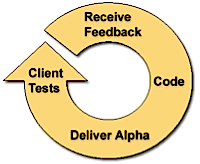There’s a lot of debate out there on the “best” way to manage a custom software project. Just Google “Waterfall and Agile” – there are over 2.2 million search results. In case you aren’t savvy to Project Management (PM) lingo, and I wouldn’t blame you if you aren’t, Waterfall and Agile are two popular styles of PM.
Waterfall is the “old school” style where each phase of the project doesn’t start until the previous one has been signed off by the client – like water flowing downhill over a series of waterfalls.
Agile is the latest PM craze because it provides a lot more flexibility for gung-ho developers in a creative process by building in frequent build & review cycles with the client. Designing and building custom software is a creative process, even though it isn’t generally recognized as such, but that’s a post for another time.
Both methodologies have been successful. People want to know which method to use for their project, and the answer is… it depends.
The Method Isn’t Going To Manage The Project For You
However, even once you’ve evaluated how involved your client is willing to be, what your team’s preference and working styles are, the type and scope of the project, and defined your end goal, neither one of these PM methodologies will guarantee success.
 Even though WaterfallPM can provide tight control over your project, you can still get into trouble with scope changes. As time goes on, the client’s needs can change. Adding in features or making major direction changes mid-point can cause the project to nosedive.
Even though WaterfallPM can provide tight control over your project, you can still get into trouble with scope changes. As time goes on, the client’s needs can change. Adding in features or making major direction changes mid-point can cause the project to nosedive.
One of two scenarios often happen with Waterfall PM.
- The project leads follow the standard change request process and determine the changes are going to come with a new, often larger price tag. Because the entire project has been planned out in advance, these changes can have major impacts. Clients can balk at increased costs, and entire projects can be compromised or even killed.
- The project leads agree to take on the new changes but don’t follow the standard change request process. This can happen in the hopes of preserving the client relationship and the project by avoiding the uncomfortable conversation of cost increases. This can lead to diminished profit margins – or even put the development team in the hole.
A highly skilled Project Manager knows how to navigate these pitfalls, and the best will be able to see these changes coming ahead of time, allowing for conversations earlier on (and with less expensive impact).
In contrast, the flexibility of Agile development is very appealing to many experienced developers. However, it isn’t well suited to every type of project.
- Agile projects are notorious for a lack of solid documentation. The quick pace and frequent changes can lead to outdated process documents, user manuals, and even client communications. Adequate PM can require a tight control over information flow.
- If the end product is already well defined with very small chances of the client’s needs changing, then the frequent client feedback cycles can be time consuming and unnecessary demands on the client’s time.
PM methodologies are intended to make your life easier, but you still have to do the work. An experienced Project Manager will craft the right balance of current documentation alongside short build & feedback cycles, and can identify ways to keep the client’s interaction to a minimum. An effective manager also communicates well with the development team, fostering a high level of understanding among team members and stakeholders.
Achieving Project Success
In short, success comes more from a competent, supportive, and proactive Project Manager who utilizes whatever method is chosen in an efficient and effective manner than from the methodology chosen.
That’s why utilizing the right PM person is still the most important approach to take.

Follow